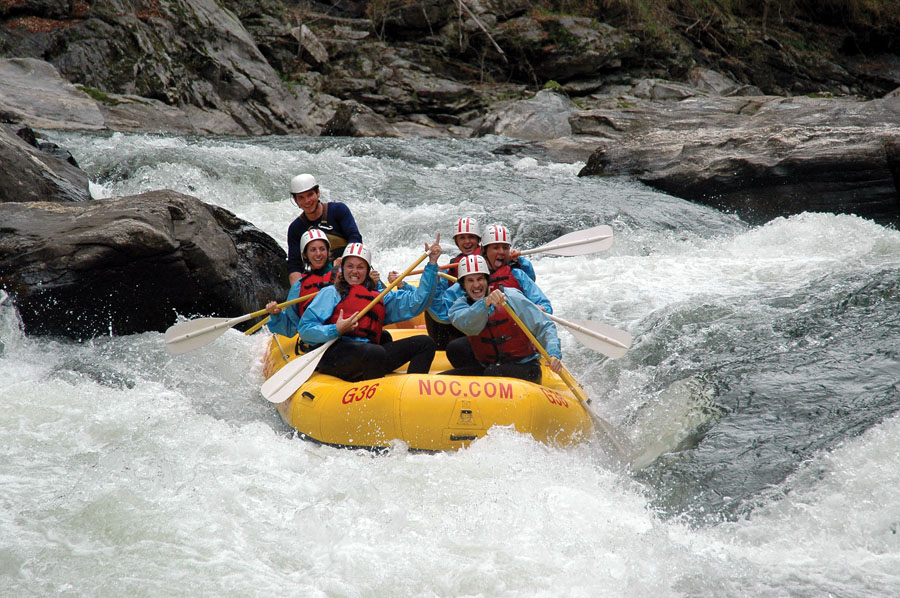Steven Foy knows well the magical feeling of paddling down the legendary Chattooga River. A Texas transplant and veteran river guide, Foy returns to the river’s roaring rapids each year. The river’s channels–and all their twists, turns and dips–call to him as they do for so many other whitewater fans, who recognize the Chattooga as one of the best whitewater experiences in the United States.
“It has … a special place in the heart of most Southeastern whitewater enthusiasts,” says Foy, who manages river operations for the Nantahala Outdoor Center.
It’s no wonder the river garners such affection among whitewater aficionados. Though it starts as little more than a trickle in North Carolina’s Blue Ridge Mountains, it builds into the Southeast’s premier whitewater experience, delivering breathtaking views and adrenaline-rushing rapids in an unparalleled natural setting. Perhaps most famous as the backdrop for the movie Deliverance, its rock-strewn whitewater offers Class II-IV rapids as the river winds its way through the gorge, culminating with the renowned Five Falls, where five Class IV rapids follow in quick succession.
Protected in 1974 under the Wild and Scenic Rivers Act, the Chattooga stretches for 57 miles before joining with the Tallulah River in Lake Tugalo, forming the boundary between Georgia and South Carolina along the way. The U.S. Forest Service manages about 70 percent of the river’s 180,000-acre watershed in the southern Appalachian Mountains, which includes portions of northeastern Georgia, western North Carolina and upstate South Carolina.
“Because of that wild and scenic designation and because of the large Forest Service ownership, it has really good water quality and a really intact ecosystem,” said Kevin Colburn of American Whitewater, a non-profit advocacy group based in Cullowhee, N.C. “It just really retains a lot of interesting character.”
Logging projects raise concerns about water quality
But maintaining that character isn’t an easy task. On national forest land, the Forest Service must attempt to balance the needs and desires of competing users, including environmentalists, whitewater rafters, timber companies and anglers. And on private land, the challenges are even greater–with conflicts among different user groups, private landowners, and local and state officials.
Another issue: because the Chattooga is fed by many tributaries and small streams, those who want to protect the river have to worry not just about what’s happening in the river itself and nearby land, but also what’s going on upstream.
Case in point: Stekoa Creek, one of the Chattooga’s largest tributaries, has been a major source of water pollution in the river for more than 40 years, and things haven’t gotten any better with the river’s wild and scenic status. The Chattooga Conservancy calls Stekoa Creek the single greatest threat to the river’s water quality, noting that the Forest Service has at times warned river users that contact with water below its confluence with the Chattooga River could put them at risk for bacterial skin infections.
Local environmental groups are also worried that a large-scale logging and forest management project in Georgia’s Chattahoochee National Forest would hamper water quality in another tributary, Warwoman Creek. After 10 years of planning, the Forest Service recently released a final project design that incorporated many elements environmentalists had been fighting for, including a one-third reduction in commercial logging, added protections for old-growth forests, the abandonment of a plan to build a mile of new road on steep slopes, plans to reduce erosion on 11 miles of existing roads, and the closure of some existing roads that have been a long-term source of sediment pollution. The final decision–announced last Halloween–is expected to reduce impacts on a rugged and remote area known as Windy Gap as well as significantly improve water quality in the Warwoman watershed.
“The Forest Service did a good job of listening to the concerns of the public and responding in a way that leads to a net benefit for water quality in this area, but still allows the Forest Service to do the work they want to do,” said Patrick Hunter, a staff attorney with the Southern Environmental Law Center in Asheville, N.C., who represented the environmental groups.
Despite this hard-fought victory for local environmentalists, they still remain concerned about timber harvesting and water quality. Only about one-quarter of the Chattooga watershed is protected from logging, including designated roadless areas, the Ellicott Wilderness Area and its “wilderness extension” study areas, and a quarter-mile buffer on either side of the river in the 15,432-acre Chattooga Wild and Scenic River Corridor.
Hunter noted that many people do not realize the amount of logging and road-building that takes place on national forest lands, thinking they are protected as public lands in the same way that national parks are. But the Forest Service has a very different mandate than the National Park Service, and that includes not just protecting forest lands but also allowing–and in many cases encouraging–timber production on them as well.
Gifford Pinchot, the first chief of the Forest Service, said the agency’s mission was “to provide the greatest amount of good for the greatest amount of people in the long run.”
That has proved to be a difficult–and often controversial–calling.
For their part, environmental groups are concerned about the effects of timber harvesting on the Chattooga, particularly from sediment entering the river from roads built to access timber harvesting areas and the accompanying traffic along those roads, including 18-wheel logging trucks and other big machinery. Too much sedimentation can coat river and creek bottoms, impairing insect growth and reproduction. That means not just cloudy water instead of the crystal clear river that epitomizes the beauty of the Blue Ridge Mountains, but also less food for fish and the animals (and humans) that rely on them.
In the worst case, a logging project can take away not just the trees that are cut down, but also destroy the very essence of a natural area. “For a hiker, where you were once walking through a forest that hasn’t been disturbed, after a lot of these trees have been removed, it’s a much different experience,” Hunter said. “You can feel the impact of man much more up close after these sorts of events.”
One way environmental groups and other interested parties can influence timber management near the Chattooga River is by participating in the forest plan revision process. These forest management plans, typically updated every 10-15 years, guide all aspects of the way these public lands are managed, including recreation and timber harvesting.
The land and resource management plans for the Sumter and Chattahoochee-Oconee national forests were finalized in 2004 and are not yet up for revision again, but the Nantahala and Pisgah national forests are currently in the process of revising their plan, with a draft environmental impact statement expected to be released by this spring.
Nicole Hayler, executive director of the nonprofit Chattooga Conservancy, said her group is hoping to see continued protections for the Ellicott Wilderness extension areas and heightened protections for Terrapin Mountain, which includes the Chattooga’s headwaters. “There’s all these incredible lichens and mosses [up there] to the point where you’re almost afraid to step on anything,” said Hayler, explaining the importance of limiting human foot traffic on Terrapin Mountain.
While environmental groups have expressed concerns about timber harvesting in the Chattooga watershed, Forest Service officials emphasized that only a very small fraction of the forest is cut in any given year. In the 530,000-acre Nantahala National Forest, for example, that amounts to about 900-1,000 acres annually–or about 0.002 percent.
Mike Wilkins, a district ranger with the Nantahala National Forest, said the agency generally avoids clearcutting, except in cases where large swaths of trees have been negatively impacted by storm events, and that only about half of the Nantahala and Pisgah national forests are currently open to some form of timber management. And he emphasized that all timber sales go through a lengthy, multi-year process that includes input from Forest Service experts–including botanists, archaeologists, foresters and biologists–as well as the general public.
“It’s not like we just go out anywhere and start cutting timber,” Wilkins said. “We take an interdisciplinary approach to the land, and we’re letting the public know what we’re thinking about doing from the very beginning.”
Forest Service officials also argue that some timber management is necessary to restore the forest to a more natural state, since past policies of fire suppression have created dense stands of white pines with little to no young oak trees or grassy openings. For example, in the Upper Warwoman project area, yellow pine-oak communities are less than half their historic range and just 1 percent of the 12,500-acre project area has young grass and tree habitat essential for deer, wild turkey and ruffled grouse. The Forest Service says five of the seven ecosystems in the project are “highly departed” from their natural state due to a lack of fire.
“Those kinds of numbers really highlight the unhealthy condition of the forest as it currently is,” said Holly Krake, a spokeswoman for the Chattahoochee-Oconee National Forest. “An analogy would be, think of any small town with no young children, nobody in middle age, no high school students, no working young adults or young families–a place with everybody being the same age. That would be a pretty unhealthy place.”
Krake also noted that the Forest Service uses other tools besides timber harvests to maintain native plants and wildlife in Georgia’s national forests. For example, on the Chattahoochee-Oconee national forests, forest managers treated more than 34,000 acres using prescribed fire in fiscal 2015. That falls in line with previous years, as foresters have treated an average of nearly 30,000 acres each year using prescribed burns over the past decade.
“The right fire at the right place at the right time helps maintain healthy forests, communities and watersheds,” Krake wrote in an e-mail.
While environmental groups also recognize the importance of fire in healthy forest ecosystems, they disagree with what the Forest Service calls restoration as well as the need for so-called restoration projects that feature timber harvesting. Hunter of the Southern Environmental Law Center noted that past fire suppression isn’t as big of an issue in the wet and humid Southeast as it has been in other national forests, particularly in the dry western states. That said, he acknowledged that many national forests are in an unnatural state currently, thanks to poor management practices in the past.
The trick, he said, will be for the Forest Service to address areas that need recovery without causing more damage than what they’re trying to repair. “The sweet spot is for the Forest Service to be able to go in and do that work to improve communities without causing the bad impacts often associated with timber sales, like road building and bringing in heavy equipment and big trucks,” Hunter said. “They need to implement science-based treatments that are beneficial to the environment.”
For now, it remains to be seen whether the Forest Service can achieve that goal in the Chattooga watershed. But Hunter and other environmentalists will be watching their efforts closely.
Another Threat to the Deliverance River
Stekoa Creek, one of the Chattooga’s largest tributaries, has been a major source of water pollution in the river for more than 40 years, and things haven’t gotten any better with the river’s Wild and Scenic status. The primary source of pollution is raw sewage from the nearby city of Clayton’s sewage collection system, along with poor agricultural practices, failing septic tanks, and dumping. The Chattooga Conservancy calls Stekoa Creek the single greatest threat to the river’s water quality, noting that the Forest Service has at times warned river users that contact with water below its confluence with the Chattooga River could put them at risk for bacterial skin infections.
[divider]related articles[/divider]








